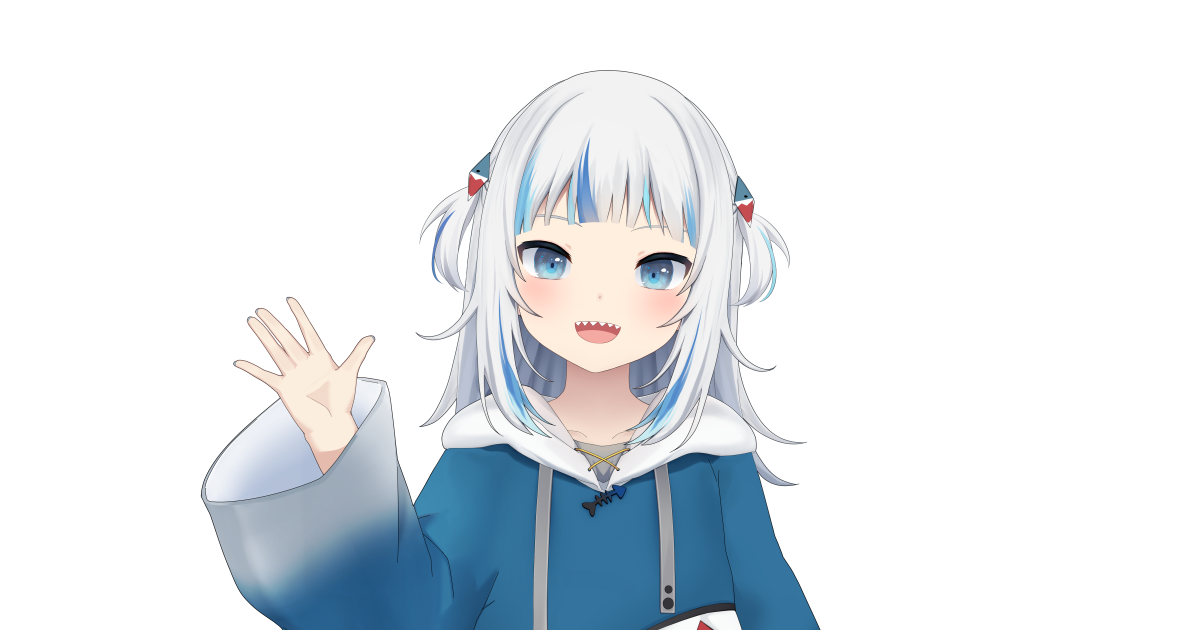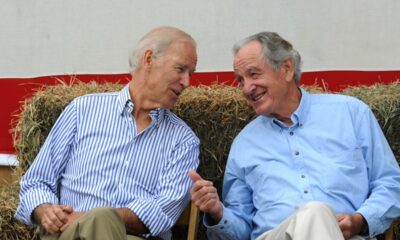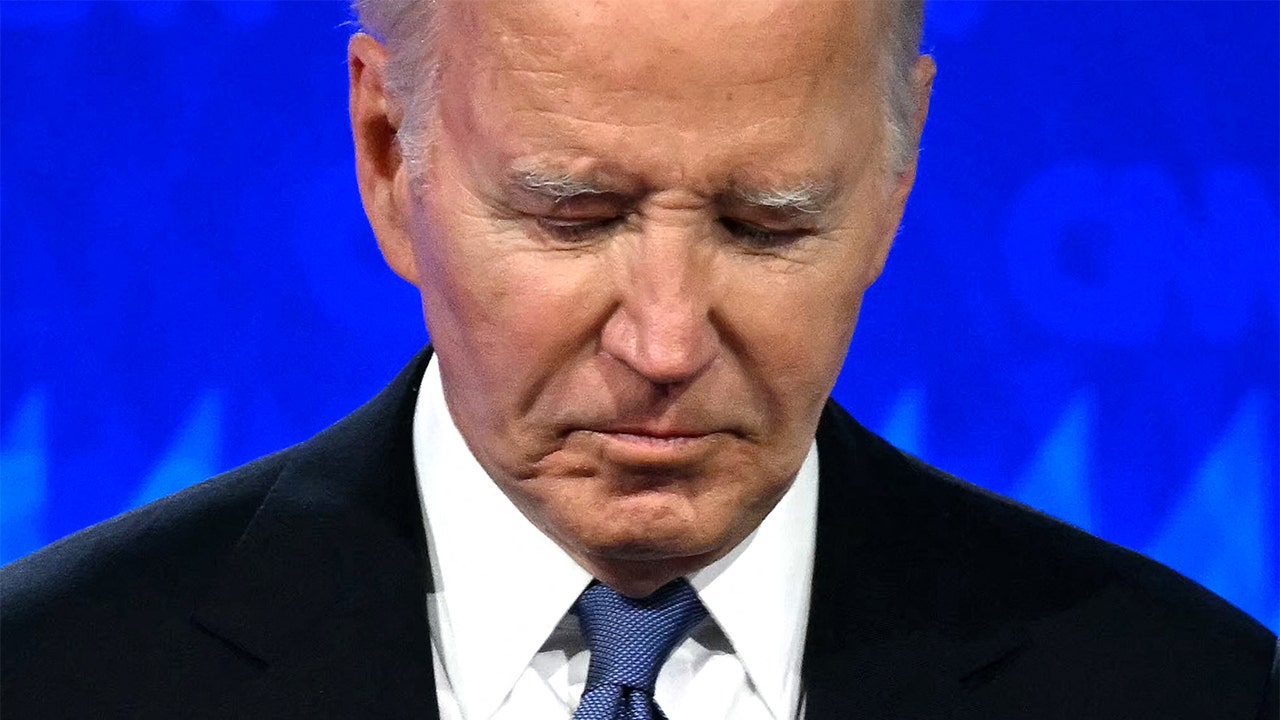Lifestyle
Move over, pickleball: In this wealthy L.A. neighborhood, another game reigns supreme

Jimmy Dunne hopped off his electric bike, hung his helmet on the handlebars and hurried over to the three bocce courts at Veterans Gardens just in time to offer his usual Tip of the Day.
“Think strategically,” the commissioner of the Palisades Bocce Club told the 50 amateur players who had gathered at the park on this chilly gray morning. At 68, he was a relative youngster compared with most of the assembled crowd. “If you’re playing against a master like Bill Skinner and you’re down in the last quarter, go hard.”
Everyone laughed. Skinner, who is 90 and plays for the OBG (Old But Great) Rollers, beamed. And the tournament began.
Player’s name tags are kept in individual team parcels in a bin for the Pacific Palisades Bocce League.
(Gina Ferazzi / Los Angeles Times)
Pickleball may have exploded in the wake of the pandemic, but in Pacific Palisades bocce is king. More than 900 people have joined the Palisades Bocce Club since it began in June 2021. In the spring season, which ended this month, 542 people played regular matches. Games take place three times a week, and while winning is nice, it has never been the point. The league prizes community over competition, bringing together neighbors of all generations to connect in the outdoors.
“None of this was ever about bocce,” said Dunne, a longtime Palisades resident and songwriter who has written for Whitney Houston and Kenny Rogers. “It’s about celebrating the wonder in our backyard and the simple pleasure of having friends in town.”
The stakes were high on this Tuesday in May — the winning team would head to the championships — but the vibe was decidedly relaxed. Roger Stewart, who’s in his 90s, rolled his ball while remaining seated on a bench. The ladies of La Bocce Vita, who wore matching black caps featuring their team name in sparkly pink letters, were more interested in planning a weekend getaway together than beating their opponents. And Skinner, a 40-year member of the local Optimist Club, wove through the crowd cracking jokes until someone told him it was his turn to roll.
Dunne, dressed in navy blue pants and a navy blue sweater, cheered them all on, his blue eyes twinkling beneath a pale pink baseball cap.
“Great shot! Just spectacular,” he called out. “Beautiful! Just a little long!”
Bocce dates back at least as far as the Roman Empire and has long been popular in Italy, but interest in the game appears to be surging in the United States.
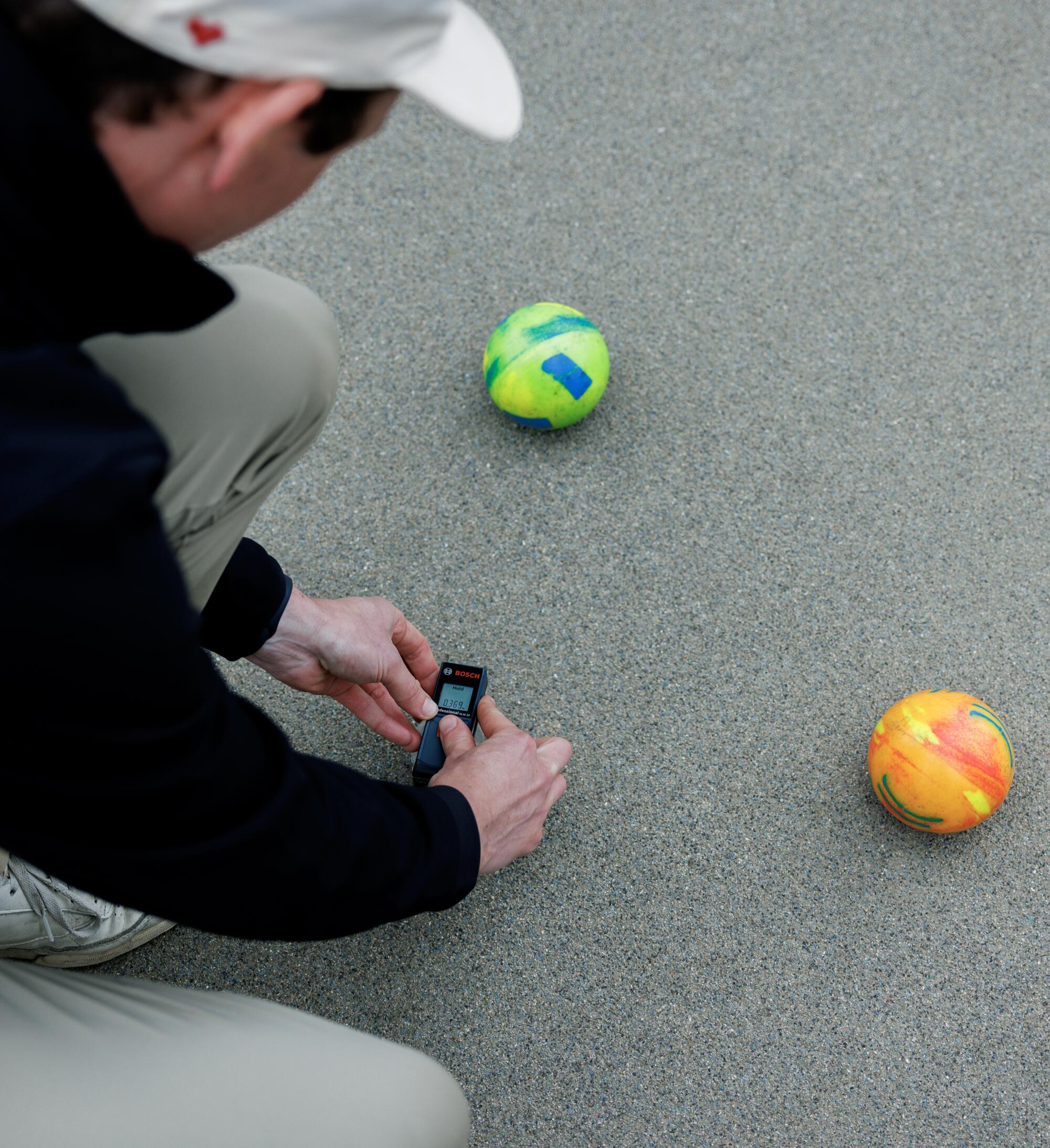
Scorekeeper Sean Barnett uses a digital measuring tool to figure out which team’s colored balls are closest to the smaller pallino.
(Gina Ferazzi / Los Angeles Times)
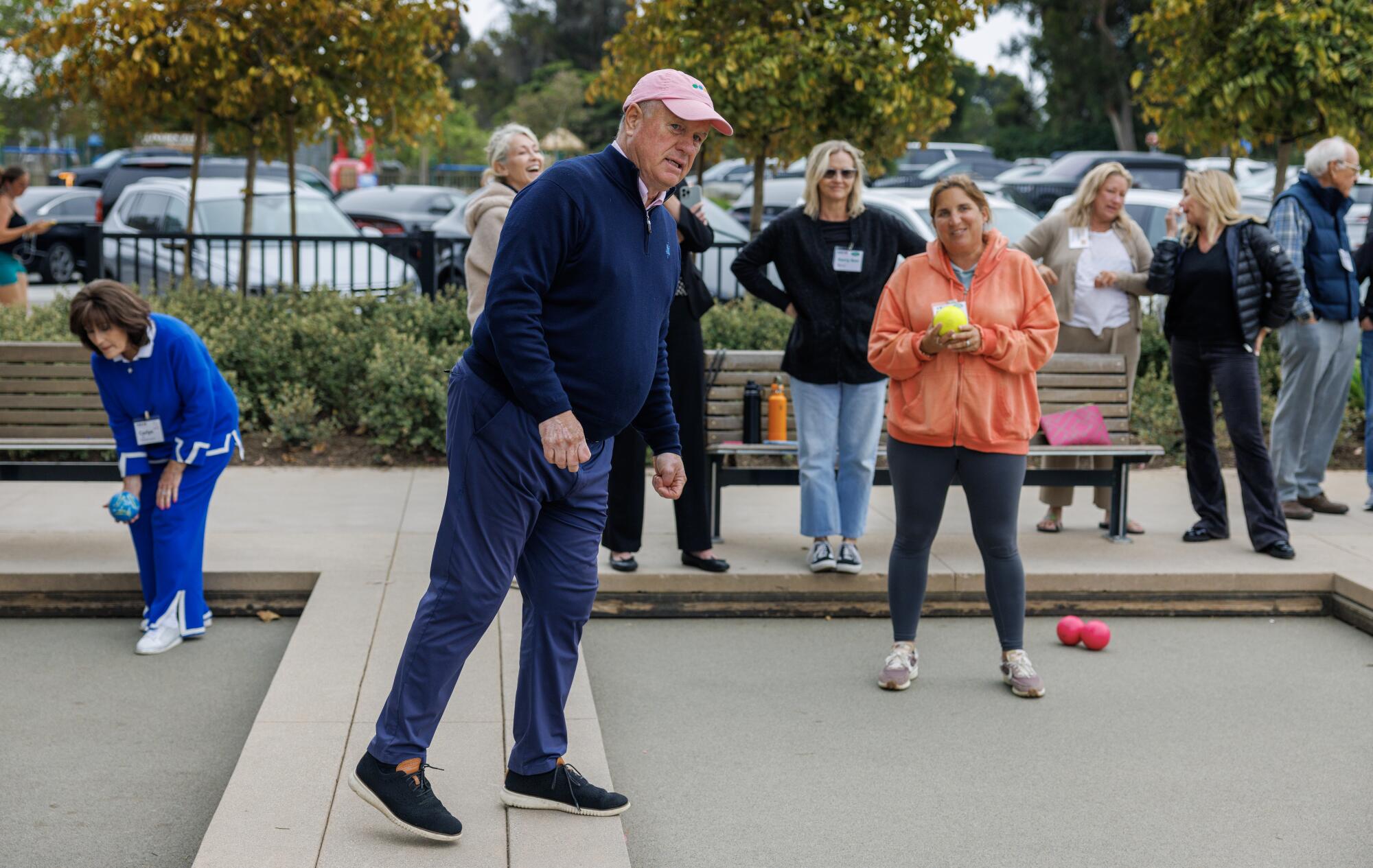
League Commissioner Jimmy Dunne watches play in-between the bocce courts during Thursday league night at the Veterans Gardens bocce courts. The courts in the pubic park were put in two years ago and currently 545 people are signed up to play.
(Gina Ferazzi / Los Angeles Times)
“Our explosion is not quite to the pickleball level, but there has been a serious uptick since COVID,” said Alex Gara, co-founder of the American Bocce Company, which runs a league with 3,000 players in Chicago as well as national tournaments. “Often there’s this magical moment where things all come together and a sport grows exponentially very quickly. A lot of people feel like that’s happening for bocce right now.”
There are several reasons why bocce has become such a sensation in the wealthy seaside community of Pacific Palisades, according to Dunne. It’s less physically demanding than tennis or pickleball, making it an accessible social activity for the Palisades’ growing senior population. It’s easy to pick up, and because it relies more on skill and strategy than strength or speed, it’s one of the few sports where a 90-year-old might easily beat a 30-year-old.
“It’s time off from life, and God, do we need it.”
— Jimmy Dunne, Palisades Bocce Club commissioner
The neighborhood’s relatively temperate climate makes it possible for seniors to play outside year-round. It’s also an excuse for older players to get out of the house and for younger players to take a break from the relentless churn of parenting and work. It costs only $75 a person to join for a season.
“Nobody has a credit card in their pocket, and aside from taking pictures, nobody’s looking at their phones,” Dunne said. “It’s time off from life, and God, do we need it.”
Dunne’s love affair with bocce began in the summer of 2010, when he stumbled across a park in the French countryside where people of all ages were gathered around what looked like a bocce court. (This being France, they were likely playing a similar game, petanque). As he took in the scene, a wedding party streamed out of a local church and joined the game.
“I had never played bocce and I had no idea what it was, but what was magical about it was that it was drawing all these people in the community to come out at sunset,” he said. He vowed to create something similar in Los Angeles.
Dunne, who was a writer and producer on “Happy Days” and counts former L.A. mayoral candidate Rick Caruso among his closest friends, is the kind of guy who gets things done. Soon after returning from his trip he convinced the Bel-Air Bay Club in Pacific Palisades, where he’s a member, to put in two bocce courts. Within months, 250 people had joined its league. Word got out and Dunne helped the game spread to Hillcrest Country Club in Beverly Hills, the Griffin Club in Cheviot Hills and the California Club in downtown L.A.
“I took on this odd role of being the pied piper of bocce,” he said. “But my interest wasn’t in bocce, it was in whether this could create belonging.”

Nancy Myers reacts with her “I Liff Bocce” teammates as they win during play for the Pacific Palisades Bocce League.
(Gina Ferazzi / Los Angeles Times)
After a string of successes with country clubs, Dunne decided to experiment with building a bocce community that was open to the public. In 2016 he and a group of friends began fundraising to build three courts on a patch of dirt near the Palisades Recreation Center. Bill McGregor, an old friend and an architect and real estate developer, drew up the plans for what became Veterans Gardens. Today it is a beautifully landscaped park with several picnic tables and barbecues in addition to the bocce courts — all of it paid for and maintained by private donations including from the local American Legion post. The park opened in 2021 at the height of the pandemic.
“I knew bocce was a thing, but this exceeded our expectations,” said McGregor, who oversaw the construction of the former Sony Music headquarters designed by I.M. Pei, among other local developments. “So many people have not used their public park since their kids were little. Now they’re using it again.”

Scorekeeper Sean Barnett walks in-between the bocce courts during Thursday league night at the Veterans Gardens bocce courts.
(Gina Ferazzi / Los Angeles Times)
Dunne is relentlessly optimistic, but even he was surprised by the league’s success. “In the country clubs people are eating and drinking the whole time,” he said. “What’s wild to me is here people come out with no cocktails and no food.”
Despite the Palisades Bocce Club’s folksy, all-American vibe, a lot of time, thought and energy has gone into making it the community hub it has become. To keep players engaged off the court, Dunne sends out a weekly newsletter with photos from recent games and announcements about who is celebrating the birth of a new grandchild or recovering from surgery.
He hired another friend, Carlyn Peterson, to manage the logistics of the league, placing people on teams, scheduling games and organizing the end-of-season dinners where awards like “The Snappies (Best Dressed in the World)” and “Happiest Campers (A Team So Full of Life)” are given out. A handful of certified bocce professionals are paid to referee the matches.
“It’s the one-two punch of providing the courts and professional programming that’s the secret sauce,” said Dunne, who volunteers most of his time but is compensated to run and manage the league. “That’s what makes it work really well.”

Diane Gallant sports two awards at the Palisades Bocce League Awards Dinner.
(Jason Armond / Los Angeles Times)

League founder Jimmy Dunne, presents awards at the Palisades Bocce League Awards Dinner.
(Jason Armond / Los Angeles Times)
Dunne would like to see the success of the Palisade Bocce Club replicated across Los Angeles, especially in neighborhoods with fewer resources than Pacific Palisades, where the average price of a house is over $3.5 million according to Zillow.
“To me there is a path to get those projects done, not by the city, but by donorship from folks who have the ability to fund it from other communities,” he said.
He’s already reached out to the City of Los Angeles Department of Recreation and Parks.
In the meantime the league is gearing up for the summer and fall seasons, and because there are more players and teams than ever before, there will be an extra spot for games on Sunday afternoons.
Skinner will be there. The ladies of La Bocce Vita have already signed up.
“When people crab about this and that and say everything is wrong in the world, I just want to say, ‘Come to the park and see,’” Dunne said. “There are some wonderful things going on.”

Lifestyle
What Is a Sundress?

Something strange unfolds online each spring. As the warmer months approach, many men seem compelled to post about the allure of a woman in a sundress. The simple wardrobe staple has long been a point of inexplicable obsession, but this year, people are asking questions.
Why do some men get so excited to see sundresses? Wait — do men even know what a sundress is? Does anyone know what a sundress is? As social media flooded with responses, it became clear that no one could quite agree on what made a sundress a sundress (as opposed to a slip dress, a day dress, a shift dress, a shirtdress, a caftan, a tube dress or a nap dress).
So we want to unravel this thread a bit, and ask you, the reader, to answer the question at hand: What is a sundress?
Many people say sundresses are bright and floral, maybe blue or yellow. White is widely accepted. Pastels are classic. Black is divisive. No one really talks about gray.
On the resale platform Depop, a seller named Bianca Steele listed a “Boho Black Sundress 100% Viscose sundress made in India.” The inky maxi was “most definitely” a sundress, Ms. Steele wrote over the in-app messenger, adding that she had personally enjoyed black sundresses for over four decades. She currently owns at least 10.
But Jeannie Stith, the chief executive of Color Guru, a seasonal color analysis company, said she can’t condone a black sundress. “In general, black has been sold to us as a universal color,” she said. “It’s actually not.”
Ms. Stith said that universally flattering shades had a mix of warm and cool tones. For sundresses, that includes peony, periwinkle, teal and sage.
While out in Lower Manhattan on a recent afternoon, three sundress-wearers — blocks apart — said a sundress can be any color that makes you happy. Though each acknowledged that being sad in a sundress was also valid.
A more joyous example — for those who believe sundresses must be colorful — floated down Sixth Avenue.
A black, slinky dress spotted in the park may not meet everyone’s parameters. Anakeesta Ironwood, 19, said she would identify it more readily as a slip dress, but acknowledged that some people might consider it a sundress, too.
“You’ve left me no choice but to mansplain women’s fashion,” Randy Trembacki told viewers on TikTok in May. Gesturing around the empty space where he would insert an image of a mini dress from Shein, Mr. Trembecki, a 30-year-old podcast producer based in Texas, named some features of a sundress: fitted top, flowy bottom.
On the phone this month, he elaborated: “It’s conservative but revealing. You know music videos circa early 2010s, where it’s the farmer’s daughter type thing?”
But he acknowledged that his viewpoint was not universal. Much of the feedback he received on his original TikTok came from Black viewers with different ideas about the quintessential sundress.
In “Sundress Pt. 2,” Mr. Trembacki addressed comments like: “Ask any black person what a sundress is and you’re gonna have the OPPOSITE answer.” In response, Mr. Trembacki included a clingy slip by Skims as an example of a sundress.
“The Black community’s preference for form-fitting, long dresses might emphasize a different aspect of allure, one that focuses on visual appeal and the celebration of body contours,” said Shelby Ivey Christie, a fashion historian and former board member of the Black in Fashion Council.
It’s close-fitting, it’s black, it has spaghetti straps — but is it a sundress? Its wearer, Yesenia Valverde, 25, said no. She considers sundresses to be something one wears on vacation and said they should be flowy and printed. She said her dress didn’t qualify mainly because of its color.
Some might consider this loose-fitting, floral-printed dress a prime example of the form. While that may be so, Renèe Monaco, 29, didn’t think sundresses needed to be flowy to qualify. A sundress is any dress a person wears in the sun, she said.
Dictionary definitions of “sundress” typically stipulate sleevelessness.
But how thick is a strap before it becomes a sleeve? Do you have to see shoulder? What about tube tops?
James Hamilton Butler, the director of the associate degree fashion design program at Parsons School of Design, shrugged off the question. Talking about sleeves is outdated, Mr. Butler wrote over email. “We can be who we want without fear of judgment. (Not sure about tube tops though!)”
Sophie Strauss, who calls herself “a stylist for regular people,” says the question of sleeves depends on what the wearer wants to get out of the sundress. In sundress-happy Los Angeles, she sees clients gravitate toward the garment because it tends to “play up parts of women’s bodies we’re told to play up, and downplay parts we’re told to hide,” she said, rattling off brands with big puffy sleeves.
Mr. Trembacki, the TikToker, was not so dogmatic on straps either. “There should be some type of strap,” he said. “Though, there could be no strap, too.”
A crewneck silhouette can be divisive in the sundress taxonomy. But its wearer says she considers her floral dress a sundress. The thin straps on this midi dress may put it firmly in sundress territory, according to some.
At some point in recent years, the sundress — traditionally homely and demure — came to take on a peculiar sexual charge. (At least for those who are extremely online.)
On the meme database Know Your Meme, a riff on Maslow’s hierarchy of needs replaces survival requirements like “water,” and “friendship,” with a refrain about sundress-induced activity, too vulgar to print.
What is it that makes “men go crazy for ‘the sundress,’” as a user on X recently put it?
Kyle Brown, a writer who lives in the Williamsburg neighborhood of Brooklyn and has a bicep tattoo of Joan Didion, offered some insight into the contemporary male gaze.
“It’s all about this pastoral American fantasy,” Mr. Brown said, describing a passionate scene involving a man who has come in from doing yardwork to find his sundress-clad wife in the kitchen baking bread. “Men are confused.”
On the street, more practical considerations still prevail.
Lexi Hide, a photographer who was wearing a Chopova Lowena dress on Fifth Avenue on a hot day, explained her reasoning. “I was thinking that a sundress has to be airy enough to make you not want to wear underwear.” She clarified that she just likes how it feels. “Nice warm breeze,” she said.
Laura Meyers, 31, donned an above-the-knee dress on a recent afternoon. She said she thought it counted, but added that, with its eclectic print and more muted palette, it may be difficult to categorize.
Gabriella Chaves, 25, deployed the “pop of red” trend when styling her long, airy white dress. She said sundresses should ideally be short — but that she still thought hers made the cut.
It may be that the sundress is more of an idea than an article of clothing. After canvassing Lower Manhattan for a potential consensus, I stopped in to Reformation, a clothing store some consider the mother ship of sundresses.
I couldn’t remember the particular sundress Ms. Strauss, the personal stylist, had mentioned, only that it was named after a type of pasta. When I asked a saleswoman for help, she encouraged me to consider any dress in the store. A sundress is whatever you want it to be, she said, pointing me to a mini fit-and-flare in the shade “Last Tango.”
Lifestyle
South L.A.'s hottest dance party happens at 'Granny's house' — and it feels revolutionary

On a breezy Saturday evening in South L.A., the sounds of heavy kick drums and electric claps trail down the block from a tan, two-story house with a well-manicured lawn. Through the large front window, passersby can catch a glimpse of a DJ in a dimly lighted living room, meticulously turning knobs on a mixer and blending house records together. In the dining room, about 15 people dance and socialize under a crystal chandelier. Dark liquor flows into red cups. A man sits between a woman’s legs as she braids his hair into cornrows, while another guest taps a tambourine to the beat of the music.
From a distance, this scene may look like a typical house party, which is exactly the allure of “Black House Radio,” a YouTube show and L.A. event series spotlighting Black DJs who specialize in house music. Throughout the gathering, no one pays much attention to the cameras recording, and for the hundreds of thousands of viewers at home, watching the videos feels like you’ve been ushered into a high energy kickback.
Winston jams out at Black House Radio.
At a time when DJs are showcasing their skills in creative ways and in sometimes unexpected settings — at parks, on elevators, at the beach, inside loft apartments, in the subway and at laundromats — “Black House Radio” stands out because of its familial charm and devotion to the genre it highlights.
“I want ‘Black House Radio’ to feel like a warm, nostalgic hug from a grandmother,” says founder Michael Donte, who’s also a filmmaker, producer and DJ. He hosts the intimate gathering roughly once a month at his best friend Jeremy’s ancestral house, which his late grandparents bought in 1963 after moving to L.A. from Millport, Ala., during the Second Great Migration. Everything in the home, including a blue-patterned couch, teal-colored carpet, vintage drapes and framed family photos, is in the same place it’s been since the 1970s.
“Black house music was made in our homes,” says Donte. He adds that he felt frustrated when he would go out and see more white DJs getting booked to play house music than Black performers, who created and popularized the genre in the 1970s. Aside from at select events like newcomer TheyHouse and Utopia, which have been elevating house music in L.A. for years. “[A white DJ is] very different than a Black person playing house music — it’s just a feeling.”
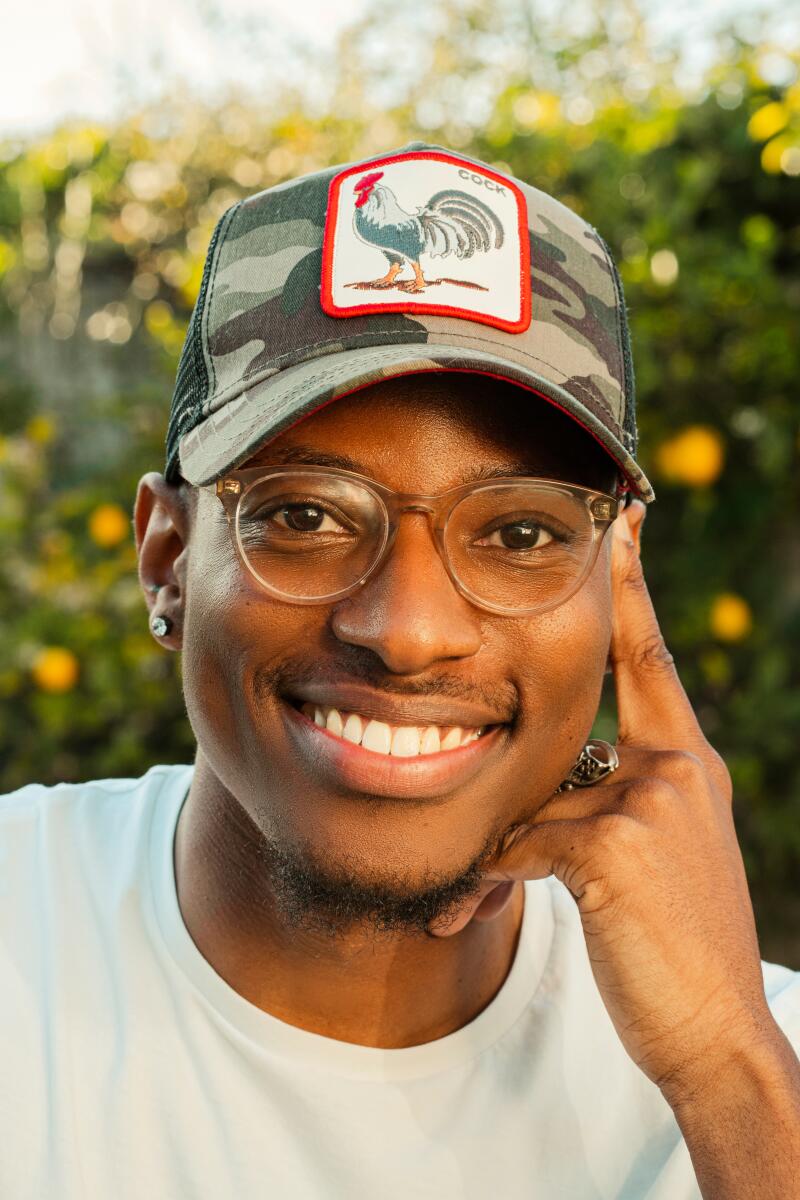
“I think my friends and I do a good job of making it a safe space for people to show up as themselves, and that’s just beautiful to watch,” says founder Michael Donte.

Family photos displayed on the wall.
After getting laid off last year from his job as a creative executive for YouTube Originals, Donte learned how to DJ, and then launched “Black House Radio” to bring the genre back home, literally, by hosting events in spaces that are vital to the Black community, such as family homes, hair salons, barber shops and churches.
Donte hosted the first “Black House Radio” event the day before Thanksgiving in 2023 and served collard greens and cornbread. About a dozen of his friends showed up with their own soul food dishes, while he and three other L.A.-based DJs — Naygod, Silhouwet, DJ Bodii — provided the soundtrack for the hours-long event.
Video by Kailyn Brown / Los Angeles Times; Photo by Zay Monae / For The Times

DJ Terrell Brooke and DJ Chinua embrace each other.
Then, in February, during Black History Month, Donte began posting live sets from that November day on YouTube, where he’s since acquired more than 50,000 subscribers and has built a community of loyal house heads who look forward to every drop. The most watched video so far is a set by Ashley Younniä, which had nearly 425,000 views on YouTube as of late June.
Some of L.A.’s most exciting DJs have been past guests, including Terrell Brooke (founder of TheyHouse and co-creator of Casual, Mez (who runs an event called Signal Underground), Rush Davis (a singer, producer, creative director and DJ) and Chrysalis (who toured with singer Rochelle Jordan).
Shaun Ross immediately knew he wanted to be a part of “Black House Radio” when one of his friends shared its Instagram page with him.
“I feel like it’s a train to get on — to actually bring back Black house music,” says Ross, a celebrated model, DJ and recording artist. He’s performed at two “Black House Radio” functions so far. “A lot of DJs don’t really play Black house music, and I feel like today, the world has this wrong notion of what house music is so when you play it, people are like, ‘It’s not hype enough. It’s not giving me a Vegas show.’”
Ross says the YouTube show also gives younger generations the opportunity to go back and look at people who are uplifting house music today. “I love that it’s Black and queer, and I love that it’s healing for everybody here,” adds Ross, who hosts a house music party called “Stardust.”
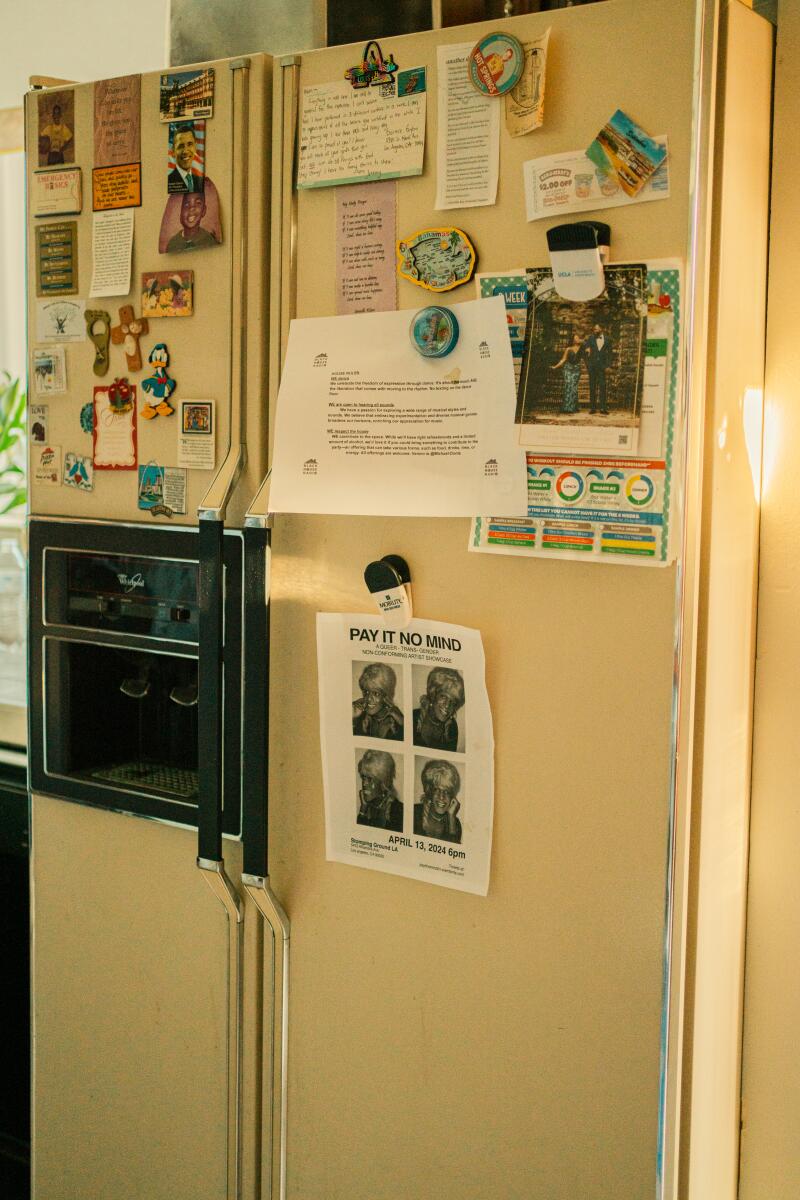
Michael Donte keeps the house as it is for each of the “Black House Radio” recordings.
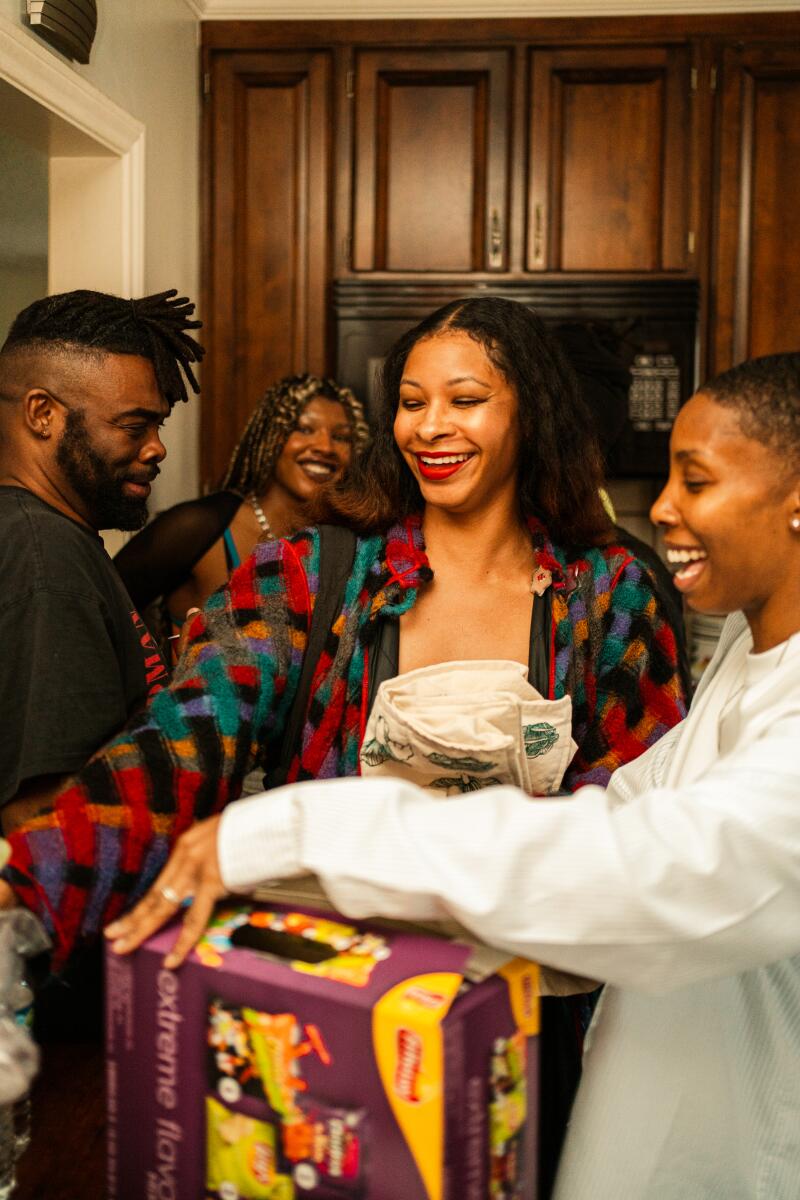
“Black House” attendees socialize in the kitchen over slices of pizza and homemade pound cake.
Back at the party, Vaughan Higgins pours herself a drink in the kitchen as other attendees grab slices of pizza and homemade pound cake. Higgins regularly goes to Black and queer events in L.A. but says being inside a Black ancestral house carries an extra layer of significance for her.
“It mainly makes me think of resistance and survival,” says the L.A.-born musician, who decided to attend because her friend DJ Nico was spinning. “The fact that this house is even still in Black hands and they are using it to bring Black joy — that is all a part of this. It’s really beautiful.”
In many of the YouTube videos, Donte infuses archival footage — some that he’s found online and others that his friends have given him — of Black families dancing at cookouts or participating in praise and worship at church — his way of preserving Black culture, he says.
“That’s one thing I feel like is missing from video streaming,” says Sevyn, who performed a groovy DJ set for ”Black House Radio” in April. “I feel like compared to other streaming things I’ve done, this one just has a story and also, I’ve been here. This is my granny’s house. It’s familiar.”
Although each of “Black House Radio’s” YouTube sets, which typically start in the afternoon and go into the evening, are invite-only due to limited space at the house, Donte has recently started hosting public events so house aficionados can enjoy the experience offline.
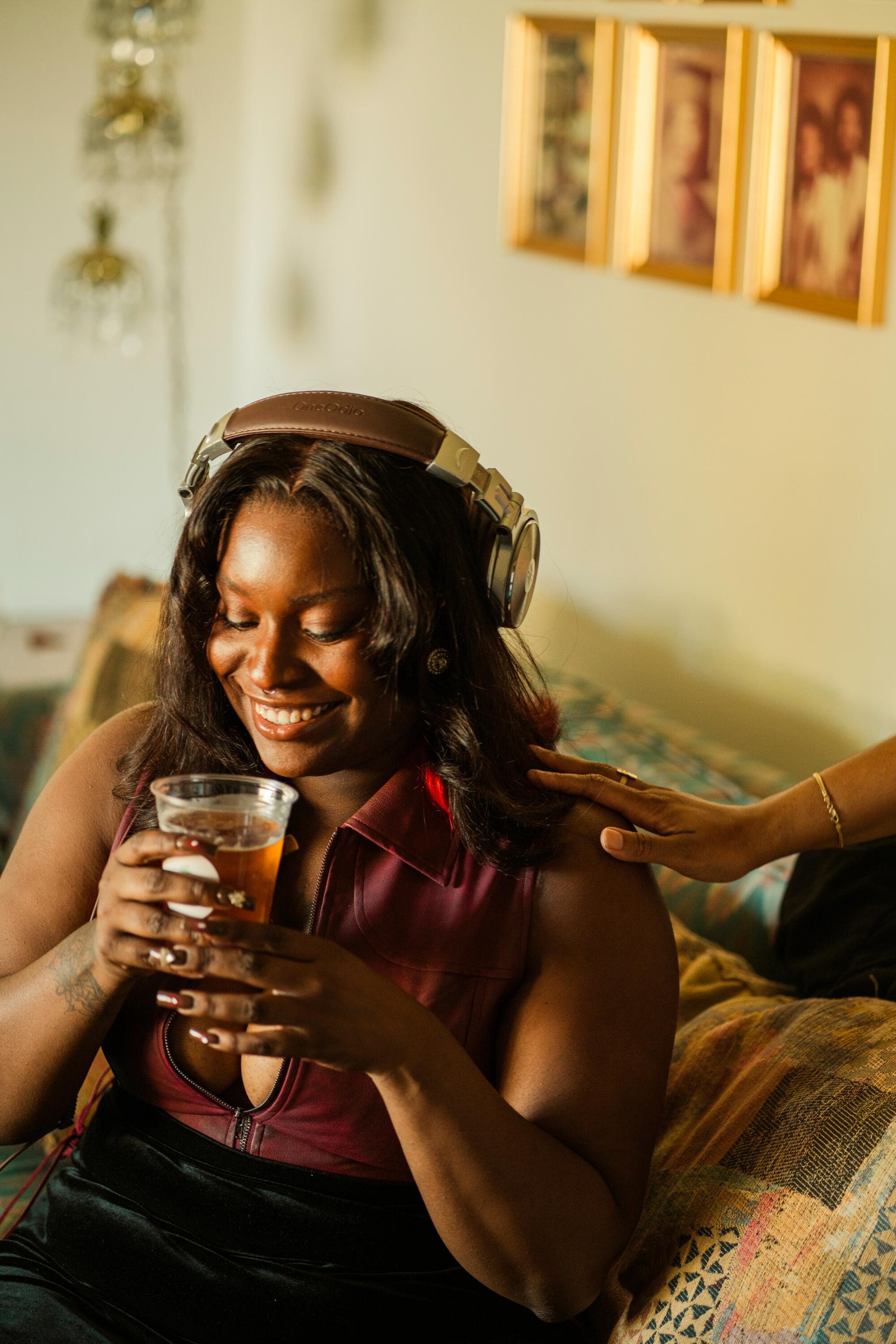
Dj Nico, a sound selector visiting from Memphis, Tenn., grins between sips of Auntie’s Coffee cold brew after her set.
The first one, called “Church,” was held in June at the Pico Union Project, a nonprofit housed in a building that was once home to Sinai Temple (built in 1909). Like at the house functions, Donte displayed framed portraits around the space, which had church pews, flameless candles and a piano. (Video cameras were here too, but Donte doesn’t plan to release a video. You just had to be there.) He’s also got his eyes set on doing a Black house music festival in the near future.
When he reflects on the rise of “Black House Radio,” Donte says he thinks people connect with the show because of its authenticity.
“It’s not trying to be unique,” he says. “It’s not trying to be something different or new. I want it to feel familiar. I want you to be able to smell what you see on that TV. You know what that house smells like. You know what the carpet feels like. You know what the food is probably on the stove.”
Video by Kailyn Brown / Los Angeles Times; Photo by Zay Monae / For The Times
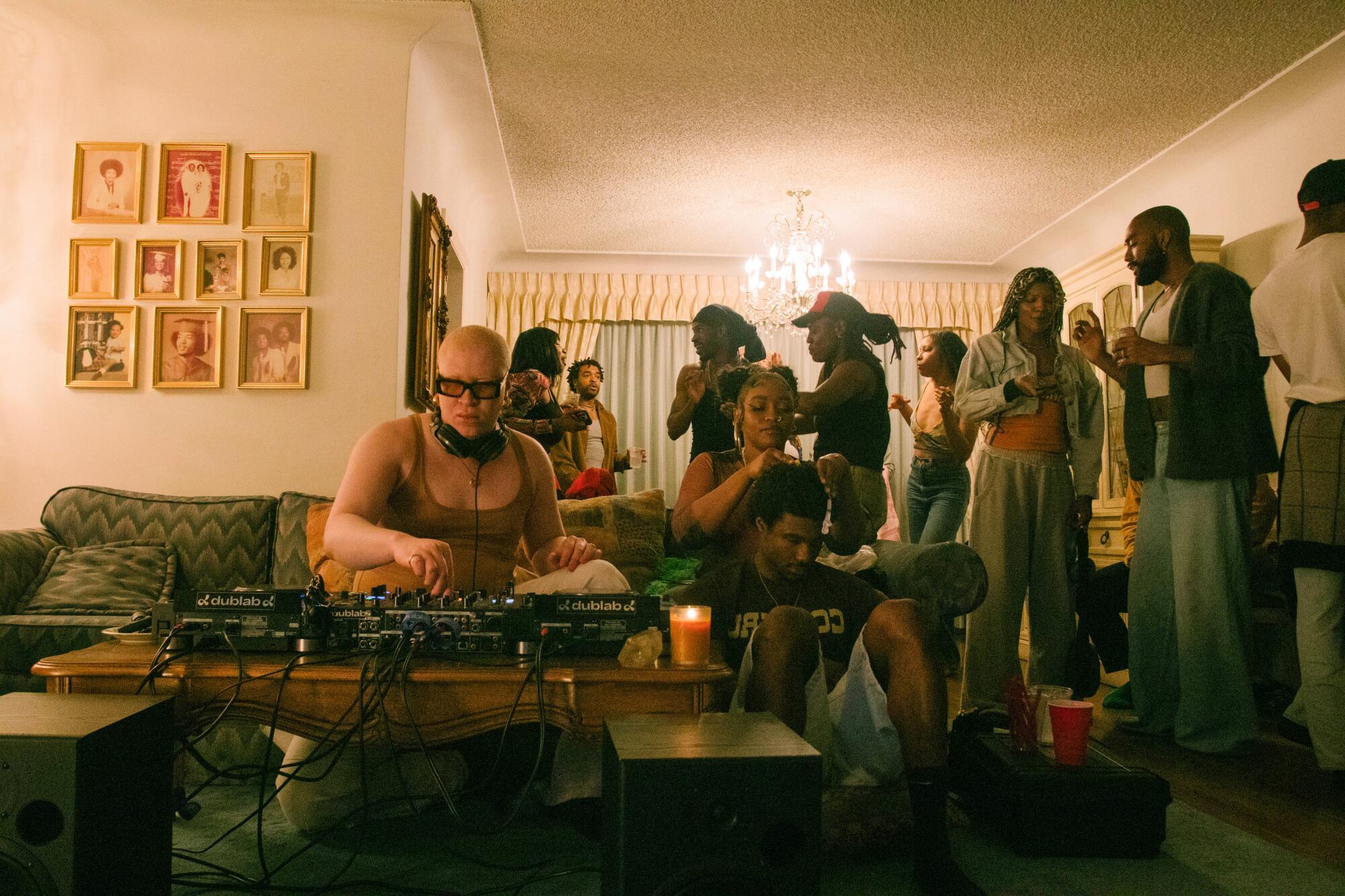
Shaun Ross at Black House Radio.
(Justin Lawson)
He adds, “I think my friends and I do a good job of making it a safe space for people to show up as themselves, and that’s just beautiful to watch.”
Around 8 p.m., when the last DJ finishes their set, one person shouts, “Keep the party going.” Donte hops back onto the decks and plays upbeat house music. Two guests vogue in the living room, and attendees socialize over more drinks. The cameras are no longer recording, but no one cares or even notices. They are in the company of family. They are at home.
Lifestyle
Hail Caesar salad! Born 100 years ago in Tijuana

The Caesar salad was born 100 years ago, on July 4, 1924, in Tijuana, Mexico. Above, the grilled romaine Caesar salad at Boucherie, a restaurant in uptown New Orleans.
Randy Schmidt/Boucherie
hide caption
toggle caption
Randy Schmidt/Boucherie
On the occasion of its 100th birthday, you can find countless versions of the Caesar salad being consumed across the United States. They’re prepared tableside at fine dining restaurants, at the counters of fast casual salad chains and served up at McDonald’s with chicken cutlets and cherry tomatoes.
Chef Nathanial Zimet insists on using boquerones in the grilled Caesar salads at his New Orleans restaurant Boucherie. The marinated white Spanish anchovies, he says, are far superior to the salt-cured kind. Romaine spears, he adds, are immune to wilting over flame.
“It’s almost like it locks in the crunch of it,” he says, as the vivid green leaves curl and darken during a quick sear. He arranges the lettuce on a plate, drizzles it with dressing (lemon, garlic, Worcestershire and Tabasco) then generously scatters chunky basil croutons and craggy parmesan shavings on top.

“Is it cold? No. Is it hot? No. Is it cooked? No. Is it charred? Absolutely.”
Not many classic dishes can claim a specific birthday. But the Caesar salad was created for the very first time on July 4, 1924, in Tijuana, Mexico.
It is not a Mexican salad, says Jeffrey Pilcher. He’s a culinary historian who studies Mexican foodways.
“This is an Italian salad,” Pilcher says. “Caesar Cardini, the inventor of the salad, was an Italian immigrant and there were many Italian immigrants to Mexico.”
Tijuana, built into a bustling border town by a mélange of people, including Mexicans, the Chinese and North Americans, had no distinctive indigenous cuisine in 1924, Pilcher says. During Prohibition, tourists flocked to its spas, bullfights and nightclubs, where they could enjoy perfectly legal cocktails.
Cardini’s original restaurant, on Avenida Revolución in downtown Tijuana, is still open for business. The original Caesar salad remains on the menu. As the story goes, Caesar’s was overwhelmed by holiday partiers on that fateful July 4. They gobbled up everything but a few pantry staples: olive oil, parmesan, egg, Worcestershire sauce and lettuce. Someone, perhaps Cardini or possibly his brother, scraped the provisions together into a big wooden bowl. Caesar’s salad was a hit.

A vegan Caesar salad.
J.M. Hirsch/AP
hide caption
toggle caption
J.M. Hirsch/AP
Over the years, the dish has morphed from what’s now called a “classic Caesar salad” (recipe here from our friends at PBS Food) into what writer Ellen Cushing has derided as “unchecked Caesar-salad fraud” in a very funny recent article in The Atlantic.

“In October,” she writes, “the food magazine Delicious posted a list of “Caesar” recipes that included variations with bacon, maple syrup, and celery; asparagus, fava beans, smoked trout, and dill; and tandoori prawns, prosciutto, kale chips, and mung-bean sprouts. The so-called Caesar at Kitchen Mouse Cafe, in Los Angeles, includes “pickled carrot, radish & coriander seeds, garlicky croutons, crispy oyster mushrooms, lemon dressing.”
But Nathanial Zimet believes the Caesar salad endures precisely because of these liberties, not in spite of them. The Boucherie chef thinks the salad can be a showcase for innovation while remaining rooted in resourcefulness and kitchen creativity. It is, he says, a salad for today. Maybe even for always.
Edited for radio and the web by Jennifer Vanasco.
-

 Politics1 week ago
Politics1 week agoBiden official says past social media posts don’t reflect ‘current views,’ vows to support admin ‘agenda’
-

 World1 week ago
World1 week agoIsrael accepts bilateral meeting with EU, but with conditions
-

 Politics1 week ago
Politics1 week agoSupreme Court to review Tennessee ban of puberty blockers, transgender surgery for minors
-

 News1 week ago
News1 week agoSupreme Court to decide whether states can restrict gender-affirming care for minors | CNN Politics
-
/cdn.vox-cdn.com/uploads/chorus_asset/file/25500699/DSCF7644.jpg)
/cdn.vox-cdn.com/uploads/chorus_asset/file/25500699/DSCF7644.jpg) Technology1 week ago
Technology1 week agoHow Apple is trying to make Final Cut Pro a “touch-first” video editing app
-

 World1 week ago
World1 week agoFar-right politician back in German court over use of Nazi slogan
-
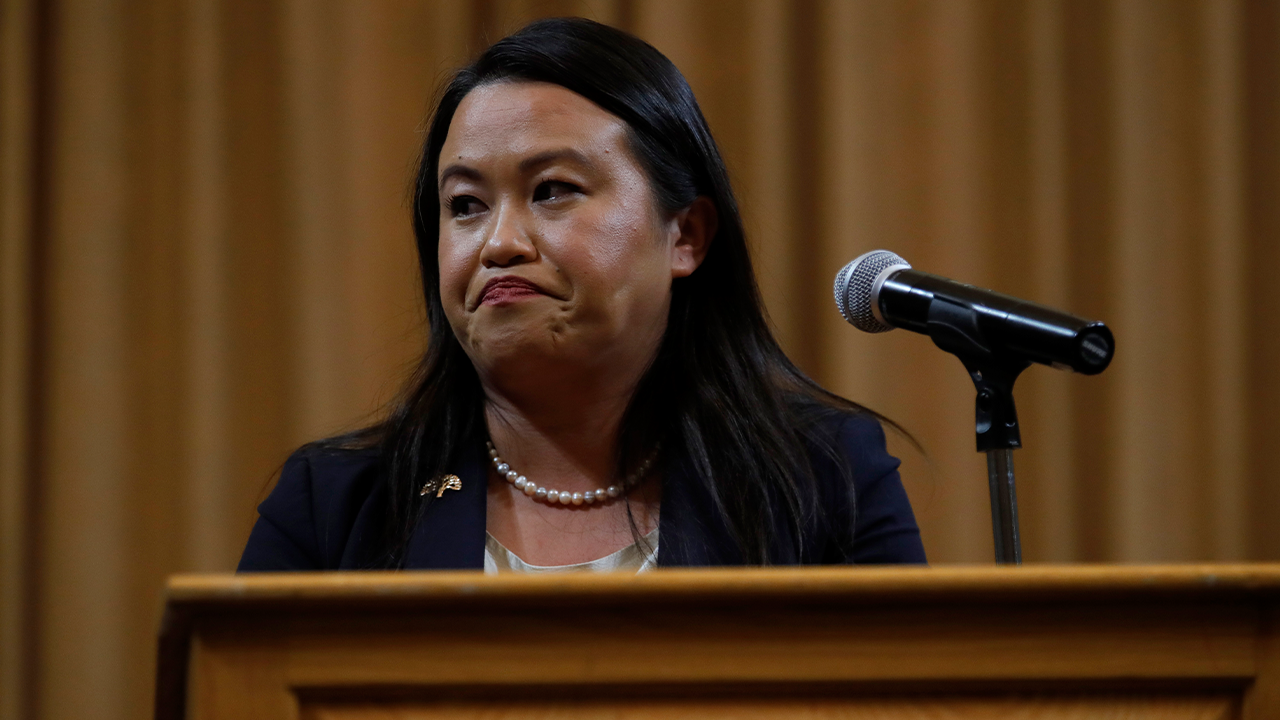
 Politics1 week ago
Politics1 week agoOakland mayor breaks silence after FBI raid: ‘I have done nothing wrong’
-

 News1 week ago
News1 week agoWhere Joe Biden and Donald Trump Stand on the Issues
